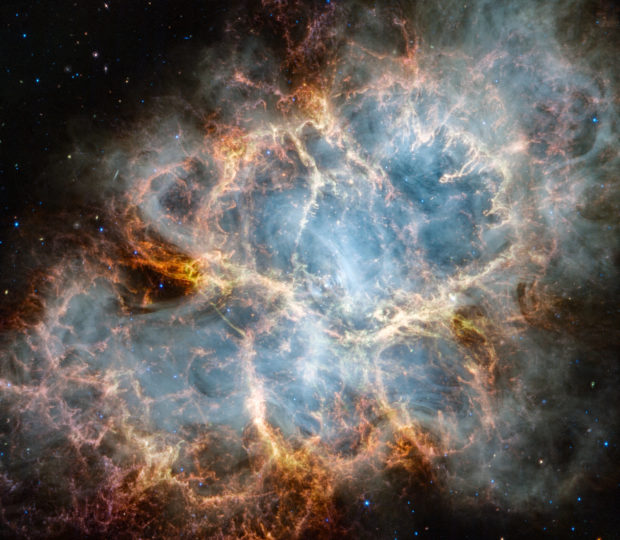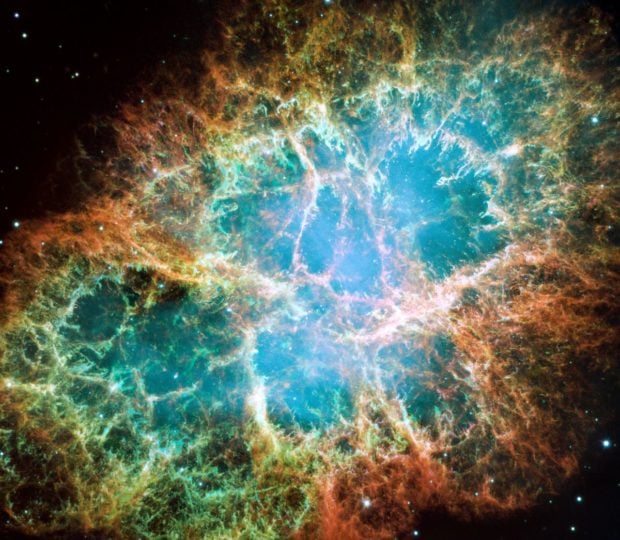Although the Crab Nebula is one of the best-studied supernova remnants, questions about its progenitor, the nature of the explosion, and the composition of its ejecta still remain unanswered. The NASA/ESA/CSA James Webb Space Telescope is on the case as it sleuths for any clues within the supernova remnant.
Webb’s infrared sensitivity, combined with data previously collected by other telescopes, offers astronomers a more comprehensive understanding of the still-expanding scene.

Similar to the Hubble optical wavelength image released in 2005, with Webb the remnant appears to consist of a crisp, cage-like structure of fluffy red-orange filaments of gas that trace doubly ionised sulphur (sulphur III). Within the remnant’s interior, yellow-white and green fluffy ridges form large-scale loop-like structures, which represent areas where dust particles reside. Image credit: NASA, ESA, CSA, STScI, T. Temim (Princeton University)
The NASA/ESA/CSA James Webb Space Telescope has gazed at the Crab Nebula, a supernova remnant located 6500 light-years away in the constellation Taurus. Since this energetic event was recorded in 1054 by Japanese and Chinese astronomers, the Crab Nebula has continued to draw attention and additional study as scientists seek to understand the conditions, behavior, and after-effects of supernovae by carefully studying this relatively close example.
With Webb’s NIRCam (Near-Infrared Camera) and MIRI (Mid-Infrared Instrument), the game is afoot as new details are uncovered – including the first complete map of dust distribution – in the search for answers about the Crab Nebula’s origins.

This is a 2005 optical image from the NASA/ESA Hubble Space Telescope of the Crab Nebula. Image credit:
NASA, ESA, CSA, STScI, T. Temim (Princeton University)
At first glance the general shape of the nebula is reminiscent of the 2005 Hubble optical wavelength image. In Webb’s infrared observation, a crisp, cage-like structure of fluffy red-orange filaments and knots of dust surrounds the object’s central area.
However, some aspects of the inner workings of the Crab Nebula become more prominent and increase in detail in infrared light. In particular, Webb highlights what is known as synchrotron emission, seen here with a milky smoke-like appearance throughout the majority of the Crab Nebula’s interior. The Hubble and Webb images of this object can be contrasted here.
This feature is a product of the nebula’s pulsar, a rapidly rotating neutron star. The pulsar’s strong magnetic fields accelerate particles to extremely high speeds and cause them to emit synchrotron radiation. Though emitted across the electromagnetic spectrum, the synchrotron radiation becomes particularly vibrant in the infrared.
To locate the Crab Nebula’s pulsar heart, trace the wisps that follow a circular ripple-like pattern in the centre, which roughly defines the location of its neutron star. Further out from the core, follow the thin white ribbons of the radiation. The curvy wisps are closely grouped together, outlining the structure of the pulsar’s magnetic fields, which sculpt and shape the nebula.
At centre left and right, the white material curves sharply inward from the filamentary dust cage’s edges and goes toward the neutron star’s location, as if the waist of the nebula is pinched. This abrupt slimming, also due to magnetic fields, results in certain areas within the supernova’s shell-like structure, most notably toward the left, emitting no synchrotron radiation.
Though the Crab Nebula’s fluffy red-orange filamentary dust cage surrounds three sides of its milky centre, in certain areas the synchrotron emission extends beyond.
Despite being outpaced by the synchrotron-emitting gas at times, clumps of dust are accelerating away from the pulsar centre as the gas bubble rapidly expands. However, because the gas is low in density, some of the dust creates sinking spindly fingers, leaving a small trace behind. Notice how the filaments tend to be longer toward the right side of the nebula, in the direction the pulsar is moving.
Within the nebula’s interior, yellow-white mottled filaments form loop-like structures, which represent areas where dust particles are forming. While astronomers previously knew dust was present in the Crab Nebula, Webb’s unparalleled infrared sensitivity has shown for the first time the full spatial distribution of where dust is located and developed.
The search for answers about the Crab Nebula’s past continues as astronomers further analyse the Webb data and consult previous observations of the nebula taken by other telescopes. Scientists will receive even more data in the near future once Hubble reimages the supernova remnant. This will be Hubble’s first look at the Crab Nebula in over 20 years, and will enable astronomers to more accurately compare Webb’s and Hubble’s findings.
More information
Webb is the largest, most powerful telescope ever launched into space. Under an international collaboration agreement, ESA provided the telescope’s launch service, using the Ariane 5 launch vehicle.
Working with partners, ESA was responsible for the development and qualification of Ariane 5 adaptations for the Webb mission and for the procurement of the launch service by Arianespace.
ESA also provided the workhorse spectrograph NIRSpec and 50% of the mid-infrared instrument MIRI, which was designed and built by a consortium of nationally funded European Institutes (The MIRI European Consortium) in partnership with JPL and the University of Arizona.
Source: European Space Agency

